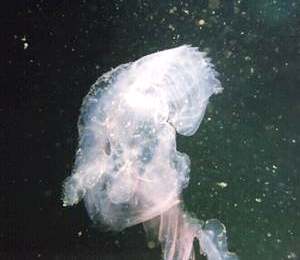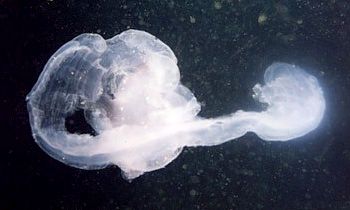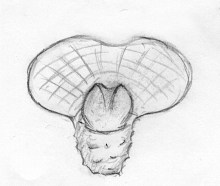Pteropods
General discussion
Related messages
Information on Corolla calceola
February 22, 2002
From: Carol
I am working on a project involving the species Corolla calceola and am having a very difficult time finding any useful information. If anyone has any specific information on this species or could lead me in the right direction with the names of a few articles I would greatly appreciate it.
Carol
vintonc@rocky.edu
Carol, 2002 (Feb 22) Information on Corolla calceola. [Message in] Sea Slug Forum. Australian Museum, Sydney. Available from http://www.seaslugforum.net/find/6331Dear Carol,
Have a look at the messages on the Pteropod Page for some general information on books etc. But my first suggestion is go to www.google.com and do a search for corolla calceola. I just did and got a list of about 16 sites with photos, a video etc. I don't know what you mean by 'useful' information but its a good starting point.
Best wishes,
Bill Rudman
Re: Pteropod or Heteropod
January 31, 2002
From: Judy Judd

Dear Dr. Rudman,
Thank you for your message about my mystery animal. I do have another picture of it, but it doesn't show the entire creature. It does show the top of the animal, and two distinct fins.
I took these pictures in the open sea, and I apologise for the quality of the images. I snapped them quickly as I descended on my dive and the water was murky.
There was a group of these animals, maybe 20 of them, in this area at the time. I only saw them once, though.
I could be overestimating the size of the animal by a bit, but I am sure that it was more than 8cm long. It had no shell. I'm sure of that. To clarify what I meant when I said that the creature was 6 to 7 inches long. That was from the fins to the end of the thin appendage that trails behind the thing in the first picture and below it in the second. The fins were about 3 inches wide, from tip to tip. Could that appendage be an egg case?
I'm sorry, I know next to nothing about pelagic snails, so if my questions seem uninformed, it is because I am uninformed.
Thank you again,
Judy Judd
judyjudd@earthlink.net
Judd, J., 2002 (Jan 31) Re: Pteropod or Heteropod. [Message in] Sea Slug Forum. Australian Museum, Sydney. Available from http://www.seaslugforum.net/find/6129Dear Judy,
Thanks for the extra photo and information. I wish it had helped me identify it for you but I'm afraid it doesn't. Most of us are very underinformed about pelagic snails and slugs. Most studies on these animals on these animals are based on preserved specimens or living specimens in various sized dishes, bowls and aquaria. While this could give us a good idea on their anatomy it gave us no clues about their biology and natural history. If you want some good information on the bilogy of living animals, have a look at:
• Lalli, C.M. & Gilmer, R.W. (1989) Pelagic Snails. The Biology of Holoplanktonic Gastropod Molluscs. Stanford University Press: Stanford, California. 259pp
I am not sure if it is possible to still buy a copy, but if not it is worth harassing your local library to see if they can get one on loan.
Best wishes,
Bill Rudman
Is this is a heteropod?
January 30, 2002
From: Judy Judd

Hi,
I have been trying to ID this animal for a while. On one forum I was told that it was a heteropod, but while doing some research on my own, I'm not so sure.
I believe the animal is a gastropod. I saw it and took its picture on the West coast of Costa Rica. It was about six to seven inches long. I will be so grateful if this can be identified. By the way, it appears white in the picture but it appeared light pink in the water. This animal was in the first 10 feet of the water column and the bottom was at 60 feet. It was in a bay, not in the open ocean.
Thanks,
Judy Judd
judyjudd@earthlink.net
Judd, J., 2002 (Jan 30) Is this is a heteropod?. [Message in] Sea Slug Forum. Australian Museum, Sydney. Available from http://www.seaslugforum.net/find/6100Dear Judy,
I'm afraid its a bit hard to know what you have from a single photo. Is the animal photographed in the sea or in a dish? Is it alive or preserved?
It could be a gynosomatous pteropod, but you say it was 6-7 inches long [approx 15cm], and the longest pteropods only reach about 8cm in length. It could be a heteropod as at least one species, Carinaria cristata, grows to about 50cm, three times the length of your animal. However I can see no sign of a shell, or for that matter any recognisable shape, which would give me some clues to what you have found. Perhaps someone will recognise it for us, or perhaps you have other photos?
Best wishes,
Bill Rudman
Re: I'm interested in pteropods
November 1, 2000
From: Andrea Di Cencio
Dear Bill,
No I haven't any photos of pteropods...
I don't know anything about pteropods...
I'm looking for some one who can tell me something about pteropods.
Thank u for your answer and bye
Andrea
pariskaroopah@hotmail.com
Di Cencio, A., 2000 (Nov 1) Re: I'm interested in pteropods. [Message in] Sea Slug Forum. Australian Museum, Sydney. Available from http://www.seaslugforum.net/find/3266Dear Andrea,
I didn't realise you were looking for some advice on where to look for information on pteropods. There are three books which are very valuable references.
The first, by Lalli & Gilmer, is particularly interesting because it describes planktonic molluscs as living organisms, with amazing photographs and onservations of them with use mucous nets for feeding etc.
The other two books, by van der Spoel, present a classical approach to these animals as dead preserved specimens and shells, with minor conchological differences being considered sufficient for species differentiation.
At this stage in our understanding of the pteropods it is important to have a knowledge of both sides of the story. Unfortunately I am not sure how easy it is to obtain any of these books.
• Lalli, C.M. & Gilmer, R.W. (1989) Pelagic Snails. The Biology of Holoplanktonic Gastropod Molluscs. Stanford University Press: Stanford, California. 259pp
• van der Spoel, S. (1967) Euthecosomata. a group with remarkable developmental stages (Gastropoda, Pteropoda). J.Noorduijn en Zoon N.V.: Gorinchem, Netherlands. 375pp
• van der Spoel, S. (1976) Pseudothecosomata, Gymnosomata and Heteropoda (Gastropoda). Bohn, Scheltema & Holkema: Utrecht. 484pp.
Best wishes,
Bill Rudman.
I'm interested in pteropods
October 31, 2000
From: Andrea Di Cencio
Hi,
I'm a student of geology and paleontology here in Italy. I'm interested in all news about pteropods... recent and fossil...
Thanx and good bye
Andrea Di Cencio
pariskaroopah@hotmail.com
Di Cencio, A., 2000 (Oct 31) I'm interested in pteropods. [Message in] Sea Slug Forum. Australian Museum, Sydney. Available from http://www.seaslugforum.net/find/3264Dear Andrea,
Welcome to the Forum. If you have any photos or observations on pteropods to share with us they would be very welcome.
Bill Rudman.
Re: Alaskan mystery
July 8, 2000
From: George Benson
Dear Bill,
Thank you for everyone's interest and efforts. I would have taken a specimen if I had known it would be so hard to identify. It is an interesting mystery. It didn't look like any of the photos. It was more cigar shaped by my recollection. We intended to see if our library can get some of the recommended books.
Thanks again.
George Benson
georgeb@seapac.net
Benson, G., 2000 (Jul 8) Re: Alaskan mystery. [Message in] Sea Slug Forum. Australian Museum, Sydney. Available from http://www.seaslugforum.net/find/2682Dear George,
It may be something quite common. It's at times like this we realise how much we rely on pictures. If you have success in finding a name for it at your library please let us know. Its nice to resolve these mysteries.
Best wishes.
Re: Gelatinous organism from Alaska
July 7, 2000
From: Erwin Koehler
Dear Bill,
Concerning the mystery from Alaska.
At my website are some nice shots of Pterotrachea coronata Forskål, 1775 - well, no OPISTHOBRANCHIA, but perhaps is the mystery of this pelagic kind.
Sorry, the text is only in German.
Have a look at: http://www.medslugs.de/D/PROSOBRANCHIA/Pterotrachea_coronata.htm
Erwin.
Medslugs.Koehler@t-online.de
Koehler, E., 2000 (Jul 7) Re: Gelatinous organism from Alaska. [Message in] Sea Slug Forum. Australian Museum, Sydney. Available from http://www.seaslugforum.net/find/2675Thanks Erwin,
They are nice photos. I didn't realise it grew to 30cm in length.
To those who are not sure what Carinaria is, it is a pelagic snail which lives its life in the plankton, hunting and eating other pelagic animals [Superfamily Carinarioidea - often called Heteropoda].
Bill Rudman.
Rudman, W.B., 2000 (Jul 7). Comment on Re: Gelatinous organism from Alaska by Erwin Koehler. [Message in] Sea Slug Forum. Australian Museum, Sydney. Available from http://www.seaslugforum.net/find/2675Re: Gelatinous organism from Alaska
July 4, 2000
From: Jeff Goddard
Hi Bill,
Regarding George Benson's message of July 1. From his description I'd guess they found either a heteropod prosobranch or a pseudothecosome pteropod opisthobranch, Corolla spectabilis. Both are pelagic, gelatinous, and good swimmers. The heteropods have a single ventral swimming fin, while the Corolla have 2 large swimming "wings". Both appendages are modified feet. Corolla has a gelatinous pseudoshell which when washed ashore looks like a rounded glass slipper with small warts on it. Some but not all heteropods (when intact) have a small rudimentary shell that covers only the viscera.
George: have a look at Pacific Coast pelagic Invertebrates by David Wrobel and Claudia Mills (Sea Challengers, 1998); it has great photos and natural history info on these organisms (but incorrectly identifies C. spectabilis as C. calceola).
PS: The other gelatinous planktonic organisms with fin like extensions of the body are the gymnosome pteropod opisthobranchs ("sea butterflies") and chaetognaths (arrow worms).
Best wishes,
Jeff
goddard@lifesci.ucsb.edu
Goddard, J., 2000 (Jul 4) Re: Gelatinous organism from Alaska. [Message in] Sea Slug Forum. Australian Museum, Sydney. Available from http://www.seaslugforum.net/find/2647
Dear Jeff,
Thanks for your thoughts on the George's gelatinous mystery from Alaska. It's always a bit difficult when you have no picture. I wondered if the animal was a pteropod. My understanding of its shape from George's message was that the wings were like the wings (cerata) of Melibe rather than the oral hood. My impression of Corolla is that it has a large bilobed wingplate (up to 50mm across) which rather dominates the rest of the body. I have added a rough sketch alongside.
My feeling is that if George's animal is a sea slug then it may possibly be a gymnosome.
I have added a page on the gymnosome Cliopsis krohni, not because I think it is the one George saw but simply because it is the only one I have a photo of. By coincidence I note that this species feeds exclusively on Corolla!
George, have a look at the pictures of these two animals and let us know if they bear any resemblance to what you saw. Pteropods are a fascinating collection of pelagic sea slugs which spend their whole life swimming and floating in the sea. The usually smaller thecosomes, have a lightly calcified shell and feed on smaller plankton, and the usually larger gymnosomes feed on the thecosomes. I have added a photo of one type of thecosome, Creseis acicula, but there are many different species with quite differenty shaped shells, including some with more typical spiral shells.
Best wishes,
Bill Rudman.
Identification of Alaskan Sea Slug
July 1, 2000
From: George Benson
Dear Experts,
While on vacation and staying at the cabin at Steamer Bay on Etolin Island in South East Alaska, the area West of British Columbia. My wife and I observed an unusual creature. It was translucent, 2 to 5 inches in length,1/2 to 3/4 inch in diameter. It was basically ovoid with something that looked a bit like a snail foot extending down from the bottom of the ovoid shape. It had several clear gelatinous fin-like projections extending from its body. It floated a few inched under the water, close to the shore along with the jelly fish and flexed back and forth in the middle perhaps once a second. About half were motionless. The seabottom varies from grassy to rocky. Nobody in the area seems to know what they are. I thought they moved like Sea Slugs that I have seen on TV. It looked slighty like Melibe leonina only it was totally clear, the fin-like structures were smaller and it didn't have a bell shaped object on either extremity. My wife was fascinated by the creatures and it would make her day or week if we could find out what they are.
Thanks,
George Benson
georgeb@seapac.net
Benson, G., 2000 (Jul 1) Identification of Alaskan Sea Slug. [Message in] Sea Slug Forum. Australian Museum, Sydney. Available from http://www.seaslugforum.net/find/2639Dear George,
It doesn't sound too much like a sea slug to me, but hopefully someone with local knowledge may recognise it,
Best wishes,
Bill Rudman.
Papers about Thecosomata
October 2, 1999
From: Carlo Magenta
Dear Friends,
I would like to receive papers about anatomy and systematics of the Thecosomata.
Please, send to:
Carlo Magenta
Rua Humberto de Campos 22/41
Embaré - Santos - São Paulo - BRASIL
11040 - 250
Thanks for attention.
Carlo Magenta
magenta@goldtec.com.br
Magenta, C., 1999 (Oct 2) Papers about Thecosomata. [Message in] Sea Slug Forum. Australian Museum, Sydney. Available from http://www.seaslugforum.net/find/1391Dear Carlo,
I have listed a couple of good books on pteropods in a reply to an earlier message from Eva Philipp which would be worth obtaining.
Bill Rudman.
Arctic Pteropods
May 27, 1999
From: Eva Philipp
Hello,
I am studying arctic pteropods in a fjord at Svalbard. I´m interested in information about arctic pteropods in general and about their behavior, if they have a vertical migration or not. I´m specially interested about the species Clione limacina and Spiratella helicina.
Thank you for any information
Eva Philipp
ephilipp@awi-bremerhaven.de
Philipp, E., 1999 (May 27) Arctic Pteropods. [Message in] Sea Slug Forum. Australian Museum, Sydney. Available from http://www.seaslugforum.net/find/886Dear Eva,
Arctic pteropods are outside my area of expertise. Hopefully someone may read this and offer some help. Two books, you are probably familiar with have loads of information on the subject and Lalli & Gilmer have wonderful information and photos of the living animals.
Lalli, C.M. & Gilmer, R.W. (1989) Pelagic Snails. The biology of holoplanktonic gastropod molluscs. Stanford University Press: Stanford, California.
van der Spoel, S. (1967) Euthecosomata. a group with remarkable developmental stages (Gastropoda, Pteropoda). J.Noorduijn en Zoon N.V.: Gorinchem, Netherlands.
Could you clarify which Svalbard you are talking about. Is it a synonym for Spitsbergen? I also have found places in Iceland and Norway with similar names. Do you travel there for regular sampling or are you planning a long stay? What happens during the winter months?
If anyone has photos of living pteropods they would fill an obvious blank page in the Forum.
Best wishes,
Bill Rudman.
Re: Arctic Pteropods
May 27, 1999
From: Eva Philipp
Dear Bill,
I´m talking about Spitzbergen. I will stay there for three month to take my samples by scuba diving. I´m not staying there in the winter times. Then the fjord is covered with ice. I don´t know about the pteropods in that season.
Thank you for the answer,
Best wishes
Eva Philipp
ephilipp@awi-bremerhaven.de
Philipp, E., 1999 (May 27) Re: Arctic Pteropods. [Message in] Sea Slug Forum. Australian Museum, Sydney. Available from http://www.seaslugforum.net/find/890Thanks Eva,
Sorry I couldn't be of more help. I don't blame you not having a look at the pteropods in the winter!
Bill Rudman.
